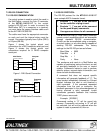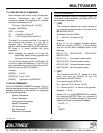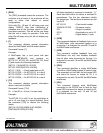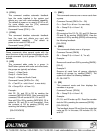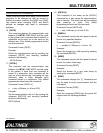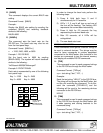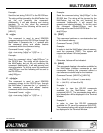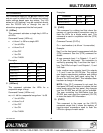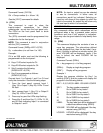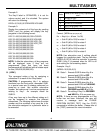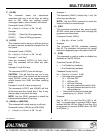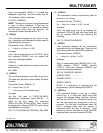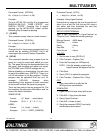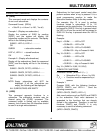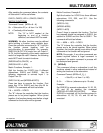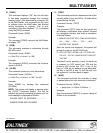
MULTITASKER
400-0402-003
17
Command Format: {CLFGk}
Gk = Group number (k = # from 1-8)
See the {CLFC} command for details.
34. {STA}
This command is used to show the
input-to-output connections for Matrix
cards/groups as set from the front panel only.
The LEDs on the front panel flash to show
connections.
The {STA} command must be programmed into
a subroutine for the front panel.
NOTE: This command is used in conjunction
with the {CLF} command.
Command Format: {WRSy=LED*=0,STA}
Sy = subroutine (n is a # from 1 to 180)
Example:
C4 is an 8X8 matrix card and the following is
programmed into the front panel:
• Keys 13-20 select inputs for C4.
• Keys 29-36 select outputs for C4.
• Sub 2 contains the following:
{WRS2=LED*=0,STA}.
• Key 2 is programmed as follows:
{WRK2=2,0,0,0,0}.
Connect Input 1 to Outputs 1 and 2 on C4 and
verify the connection. Use the following steps:
1. From the front panel, connect Input 1
(Key 13) to Output 1 (Key 29). LEDs 13 and
29 flash.
2. Next, connect Input 1 (Key 13) to Output 2
(Key 30). LEDs 13 and 30 flash.
3. Press any key and the LEDs stop flashing.
4. Press Key 2 and then Key 13. LEDs 13, 29,
and 30 flash indicating Input 1 is connected
to Outputs 1 and 2.
NOTE: An input or output key can be selected
to see its connections. In either case, all
connections would be indicated. Selecting an
input key will show all the outputs to which the
input is connected. An output key will show only
the one input to which it is connected.
KEY COMMANDS
Key commands define which subroutines will be
performed when a key is pressed under various
conditions and how it will respond to activation.
Keys may also be given labels to help identify their
usage.
35. {RDK}
This command displays the contents of one or
more key programs. The subroutines defined
will be displayed first, then the key label, if any.
Next, if the key is defined as volume control, the
word VOLUME will be displayed. Lastly, if the
key is locked, the word LOCKED will be
displayed.
Command Format: {RDKn}
Kn = key program (n = # of key program)
{RDKn}: Display a single key program.
{RDK*}: Display all key programs.
Example 1:
Display the program definition for Key 1 by
sending {RDK1} and the system will display the
program in the following format:
KEY1 : 2,5,10,20,30 LABEL VOLUME LOCKED
KEY1 The key number requested.
2 Go to SUB2 for key state 1.
5 Go to SUB5 for key state 2.
10 Go to SUB10 for key state 3.
20 Go to SUB20 for key state 4.
30 Go to SUB30 for key state 5.
LABEL The key label text will be displayed if
a label was defined using {WRLK}.
VOLUME VOLUME will be displayed if the key
was set using {SETVK}.
LOCKED LOCKED will be displayed if the key
was locked using {LOCK}.



